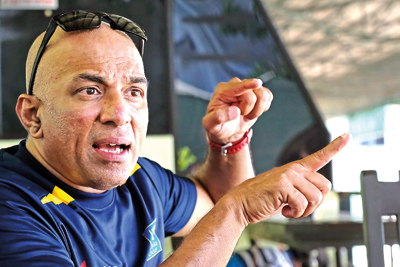Hathurusingha unveils his plans for World Cup 2019
View(s):
Pic by Amila Gamage
The Sunday Times got the opportunity of firing the salvo at national coach Chandika Hathurusingha. However, the concerns came from another angle. He feels taking the cricketing poses by the horn is an occupational hazard and that is his forte, but, what he did not expect was the eroding discipline that has hit us like a bad dream.
Describing it as a big challenge, he said “I never expected our discipline to be at this level. It’s international cricket and playing for your country is a pride. How we behave when you wear that cap is very important. Even when you are not wearing the cap, discipline is very important on and off the field. When you are wearing the national cap, you are not just Chandika Hathurusingha, you become an ambassador representing your country. Then only the responsibility of wearing the national cap comes into focus. So morning, noon and night, a national cricketer must act with that responsibility in mind. It does not matter when you are with your kids, the rest of the family or just friends, there is a certain responsibility resting on your shoulders. Yet, I am disappointed; we have dropped our guard at this juncture and this has caused some serious concerns.”
When we asked how he hoped to combat that situation, Hathurusingha said, “I am not a policeman. It is up to the individual player to add value to the national crest and act responsibly. If there were instances when we had faced certain dicey situations in the past, it is time to close the doors behind them and think of the future and move on. This is a challenge that I did not foresee before I moved to this position. Now I have to maneuver through these obstacles and give second chances to those who deserve them and move ahead with the challenges facing Lankan cricket and take them to the next World Cup and beyond.”
Hathurusingha began the discussion describing matters pertaining to the white ball and answering the question as to why Sri Lanka is low in its performances in the past two and a half years, ten months of which were under him as national coach. He said, “First we have to look at the overall picture to ascertain as to why we are in this position. We have had our highs at certain instances, but overall the situation has been different.”
“We would discuss them on an overall point of view rather than discussing individuals. In the past ten months, the plan that I had for the white ball cricket was – when I came into the system I looked at the areas that needed improvement. One area was the limited overs game. We are in the eighth position in world cricket in terms of batting on the fall of the fifth wicket – our average score is around 185 runs. The next was Australia and Bangladesh they are twenty one runs ahead of us. The best was India. They are nearly 70 to 80 runs ahead of us. When they lost their fifth wicket they are around 260 runs. This is one area that we have focused on. Our Key Performance Indicator is that we have to use 50 overs within our first seven batsmen.
“Then we should look at our overall scores and results. Since the last World Cup, of the thirty odd games, we have managed to win only nine matches. Of the nine games, we have scored over three hundred runs only on three occasions. If my memory serves right – when we were playing South Africa when we scored 248, we still lost the game; that was the highest total for some time then.
“Then we realised that we bat better when we chase. All three times that we topped the three hundred mark; we were chasing. We realised that when we are playing on certain type of wickets we have performed better. Once against Zimbabwe and once against India, playing on good wickets, we have done well, on certain occasions. I feel that it is the mindset that we have to address.
“Playing on slow wickets at home, we keep losing and that has affected our performance. So after the third ODI game against South Africa, we decided to change our approach, which included the wickets that we played on. We began to work towards the World Cup 2019. We began to see the positive results. In the first game after the shift; the opposition scored over three hundred, but we managed only 290 odd. But, we won the next game by scoring 300 runs in only 39 overs. Thereafter, we managed to top the 300 mark on a couple of occasions. Result-wise this does not reflect properly because either the opposition has played better or we have other weaknesses. (We are still talking about our batting). When you make a mind shift on an approach like that, it includes batting skills, bowling skills and fielding skills. To my mind, we have arrived at a certain junction. From here, we have two more series,” explained the national coach.
He said when he joined in as coach in January, the team had only about three fit fast bowlers. “Now we have increased that larder to around 8-9 battle-fit fast bowlers. Now it is up to our coaching team and the players to handle the battery of fast bowlers in a sustainable manner so that they will be readily available for the next few assignments upto the 2019 World Cup.”
Hathurusingha said, “We did not pull out all our aces because we were playing in Lankan conditions. We did not expose them much during the Test series, because the conditions are not conducive to fast bowling, but during the one-dayers, we included several combinations. We had Dushmantha Chameera and Nuwan Pradeep playing. Then we had the combination of Dushmantha Chameera and Lasith Malinga bowling in tandem. Our intention is to have bowlers with at least fifteen ODIs behind them when we arrive in London for the next ICC World Cup. So, when you are concentrating in combinations for the World Cup, we may lose a few ODIs by the way. We are mainly concentrating on the bigger picture. For instance Kasun Rajith should have at least fifteen games behind him by the time the World Cup begins.”
 Then we also started working on the spin department. “We have to look at spin bowlers who could take wickets in those conditions where the World Cup is taking place. We looked at the best attacks in the arena. Who is the number one in the ODIs and who is number two. Who has a better chance of winning the World Cup at this point? We put down England as number one and behind them came India. Then we ascertained what their strengths were. Who won the ICC Champions Trophy in English conditions – Pakistan! Then we realised that most of these combinations had wrist spinners in their midst. Those wrist spinners were taking wickets in the middle and winning matches for them. Taking the English conditions, even bowlers like R. Ashwin or Ravindra Jadeja have not been penetrative. In those conditions, it is the leg spinners who have dominated – bowlers like Shadab Khan of Pakistan and Adil Rashid of Afghanistan. When you take our spin bowling strengths into consideration, we have to assess how much cricket that they have played and how effective they have been.
Then we also started working on the spin department. “We have to look at spin bowlers who could take wickets in those conditions where the World Cup is taking place. We looked at the best attacks in the arena. Who is the number one in the ODIs and who is number two. Who has a better chance of winning the World Cup at this point? We put down England as number one and behind them came India. Then we ascertained what their strengths were. Who won the ICC Champions Trophy in English conditions – Pakistan! Then we realised that most of these combinations had wrist spinners in their midst. Those wrist spinners were taking wickets in the middle and winning matches for them. Taking the English conditions, even bowlers like R. Ashwin or Ravindra Jadeja have not been penetrative. In those conditions, it is the leg spinners who have dominated – bowlers like Shadab Khan of Pakistan and Adil Rashid of Afghanistan. When you take our spin bowling strengths into consideration, we have to assess how much cricket that they have played and how effective they have been.
“Then we wrote down our spinning options and we put down that we have Akila Dhananjaya. However we hope that he would come out of that present predicament unscathed. Then we have to look at some who could support him in this endeavour. We have support bowlers like Jeffrey Vandersay and Lakshan Sandakan; they are some of the bowlers that we have in mind. Now it is upto us to take them to the expected levels. Yet, in overall form, I think now we have a squad of about twenty two players, whom we have in our mind when it comes to the World Cup 2019. The tough part is from this point onwards; we only have eight more ODIs before the World Cup and we have to make the maximum of it. Historically, we have not done well against South Africa and New Zealand even when we played with more reputed players of the past. So, there is a challenge. We are not saying that we are going to win the next World Cup. But, I assure that we and our combination would be very competitive at the next World Cup”.


